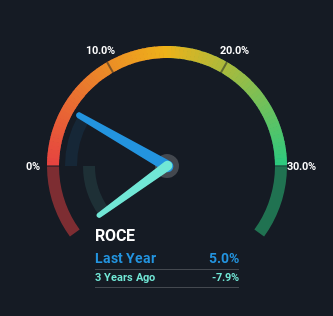The Returns On Capital At Cooper-Standard Holdings (NYSE:CPS) Don't Inspire Confidence
To avoid investing in a business that's in decline, there's a few financial metrics that can provide early indications of aging. A business that's potentially in decline often shows two trends, a return on capital employed (ROCE) that's declining, and a base of capital employed that's also declining. Basically the company is earning less on its investments and it is also reducing its total assets. So after we looked into Cooper-Standard Holdings (NYSE:CPS), the trends above didn't look too great.
Return On Capital Employed (ROCE): What Is It?
Just to clarify if you're unsure, ROCE is a metric for evaluating how much pre-tax income (in percentage terms) a company earns on the capital invested in its business. The formula for this calculation on Cooper-Standard Holdings is:
Return on Capital Employed = Earnings Before Interest and Tax (EBIT) ÷ (Total Assets - Current Liabilities)
0.05 = US$61m ÷ (US$2.0b - US$805m) (Based on the trailing twelve months to September 2023).
Therefore, Cooper-Standard Holdings has an ROCE of 5.0%. In absolute terms, that's a low return and it also under-performs the Auto Components industry average of 12%.
See our latest analysis for Cooper-Standard Holdings
Above you can see how the current ROCE for Cooper-Standard Holdings compares to its prior returns on capital, but there's only so much you can tell from the past. If you'd like to see what analysts are forecasting going forward, you should check out our free report for Cooper-Standard Holdings.
So How Is Cooper-Standard Holdings' ROCE Trending?
We are a bit anxious about the trends of ROCE at Cooper-Standard Holdings. Unfortunately, returns have declined substantially over the last five years to the 5.0% we see today. On top of that, the business is utilizing 35% less capital within its operations. The fact that both are shrinking is an indication that the business is going through some tough times. If these underlying trends continue, we wouldn't be too optimistic going forward.
While on the subject, we noticed that the ratio of current liabilities to total assets has risen to 40%, which has impacted the ROCE. Without this increase, it's likely that ROCE would be even lower than 5.0%. While the ratio isn't currently too high, it's worth keeping an eye on this because if it gets particularly high, the business could then face some new elements of risk.
The Bottom Line On Cooper-Standard Holdings' ROCE
In summary, it's unfortunate that Cooper-Standard Holdings is shrinking its capital base and also generating lower returns. This could explain why the stock has sunk a total of 76% in the last five years. With underlying trends that aren't great in these areas, we'd consider looking elsewhere.
Since virtually every company faces some risks, it's worth knowing what they are, and we've spotted 3 warning signs for Cooper-Standard Holdings (of which 1 is potentially serious!) that you should know about.
If you want to search for solid companies with great earnings, check out this free list of companies with good balance sheets and impressive returns on equity.
Have feedback on this article? Concerned about the content? Get in touch with us directly. Alternatively, email editorial-team (at) simplywallst.com.
This article by Simply Wall St is general in nature. We provide commentary based on historical data and analyst forecasts only using an unbiased methodology and our articles are not intended to be financial advice. It does not constitute a recommendation to buy or sell any stock, and does not take account of your objectives, or your financial situation. We aim to bring you long-term focused analysis driven by fundamental data. Note that our analysis may not factor in the latest price-sensitive company announcements or qualitative material. Simply Wall St has no position in any stocks mentioned.

